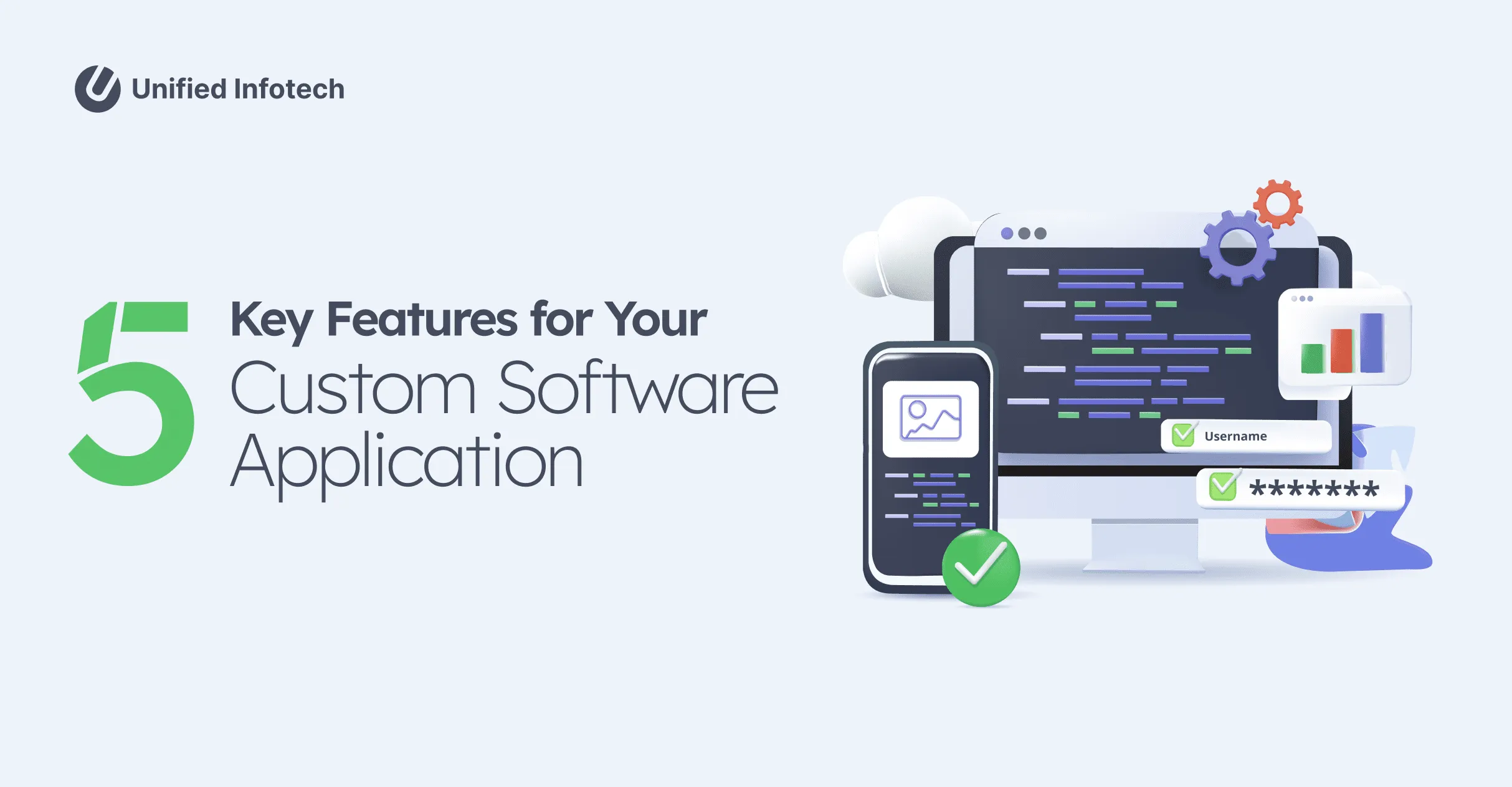Unlock Expert Advice with Zero Commitment.
We’ve Eliminated the Barriers.

Generic software solutions often fall short of meeting the unique needs of a business. This mismatch can lead to inefficiencies, frustrations, and missed opportunities. But what about a custom software solution precisely tailored to match specific business objectives?
By incorporating these 5 key features, a business can build an application that drives growth and success.
So, let’s explore!
Modular architecture is a custom software application development paradigm. It decomposes a system into discrete, interchangeable units called modules. Each module encapsulates specific software features and functionality and operates independently, promoting system flexibility, maintainability, and scalability.
Key Benefits:
Implementation Considerations:
Technical Example: In a custom ERP system, modules for inventory management, order processing, and finance can be developed independently. Microservices architecture with modular software design can be employed, with each module as a separate service. Dependency injection can manage data sharing and communication between modules.
This custom software development process allows for agile development. In addition, the modular approach helps in the independent scaling of modules based on business needs, as well as easier maintenance and updates.
Scalability is essential in custom software application development to accommodate increasing workloads without compromising performance. It involves strategic planning for both horizontal and vertical scaling.
Key Benefits
Implementation Considerations
Technical Example: A high-traffic e-commerce custom software application can leverage autoscaling groups in cloud platforms like AWS. This dynamically adjusts server instances based on real-time traffic, optimizing resource utilization. In addition, such a great custom software solution ensures robust performance by preventing performance degradation during peak load periods.
Security is a critical component of custom software application development. A software developer must embed robust measures to safeguard against data breaches, unauthorized access, and other cyber threats.
Key Benefits:
Implementation Considerations:
Technical Example: In a financial custom software application, robust security is paramount. Implementing RBAC to define user roles and permissions, along with MFA for added protection, is crucial. Encrypting sensitive financial data with AES-256 and using TLS 1.2+ for secure communication protects against data breaches. A custom software application development company ensures these security measures are built into the system.
Integration is a cornerstone of modern custom software application development. Seamlessly connecting with existing systems and third-party services creates a cohesive digital ecosystem. Effective API management and data integration are vital for efficient operations.
Key Benefits:
Implementation Considerations:
Technical Example: A custom CRM system can leverage an API gateway to manage interactions with email marketing tools and analytics platforms. RESTful APIs enable data exchange, while middleware handles data transformations. Cross-platform routes can facilitate data exchange, while middleware handles data transformations. Webhooks can trigger actions based on CRM events, such as sending automated emails or updating analytics.
Automated testing and continuous integration/continuous deployment (CI/CD) are indispensable for modern custom software application development. A custom software application development company can significantly benefit from these practices to ensure code quality, accelerate development timelines, and deliver reliable software solutions.
Key Benefits:
Implementation Considerations:
Technical Example: A custom software application development company can establish a CI/CD pipeline for a SaaS application. It automatically builds, tests, and deploys code to staging environments. Software developers and testers conduct unit and integration tests and provision infrastructure using IaC. Successful deployments are promoted to production, while failures trigger automated rollbacks. These pipelines ensure efficient deployment and reduce the chances of errors, creating a robust and reliable custom software solution.
Developing a custom software application is a strategic decision. By incorporating these five essential features, businesses can create a powerful tool tailored to their unique needs. A reputable custom software application development company can guide you through the process, ensuring your application is successful.
Key features of the software include modular architecture for flexibility, scalability to accommodate growth, robust security mechanisms, integration capabilities for seamless interoperability, and automated testing within a CI/CD pipeline for reliable deployment. These features are essential in both custom software application development and in general software solutions to ensure the software meets business needs effectively.
The time it takes to develop a custom software application can vary depending on the project's complexity, scope, and required features. On average, a custom software application development company may take anywhere from a few months to over a year to design, build, and deploy a fully functional custom software solution. The timeline can be affected by factors like modular software design, integration needs, and testing requirements.
Yes, an application developer can be a software developer. Both roles involve designing, coding, and testing software, but an application developer focuses specifically on creating and maintaining custom software applications. A software developer might work on a broader range of software solutions, including system software, middleware, and more.
While both application developers and software developers share similar skills and responsibilities, their focus areas differ. An application developer specializes in building specific software applications, often focusing on user interface and user experience. A software developer may work in a broader range of custom software solutions, including system software, tools, and infrastructure.
Examples of custom-made bespoke software include tailored ERP systems, customized CRM platforms, specialized e-commerce solutions, and industry-specific custom software applications. These solutions are built by custom software application development companies to meet the unique needs and objectives of individual businesses.
The types of customized software include custom software applications for specific business processes, modular software designs that allow for flexibility and scalability, cross-platform software for multiple devices, and integrated software solutions that connect with existing systems. These can be developed by custom software application development companies to cater to a variety of business needs.
We’ve Eliminated the Barriers.
We stand by our work, and you will too.